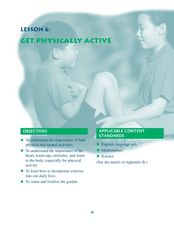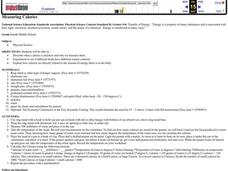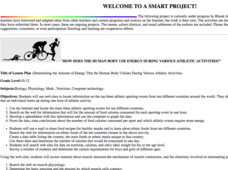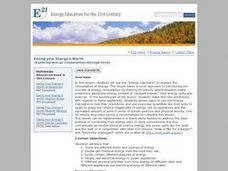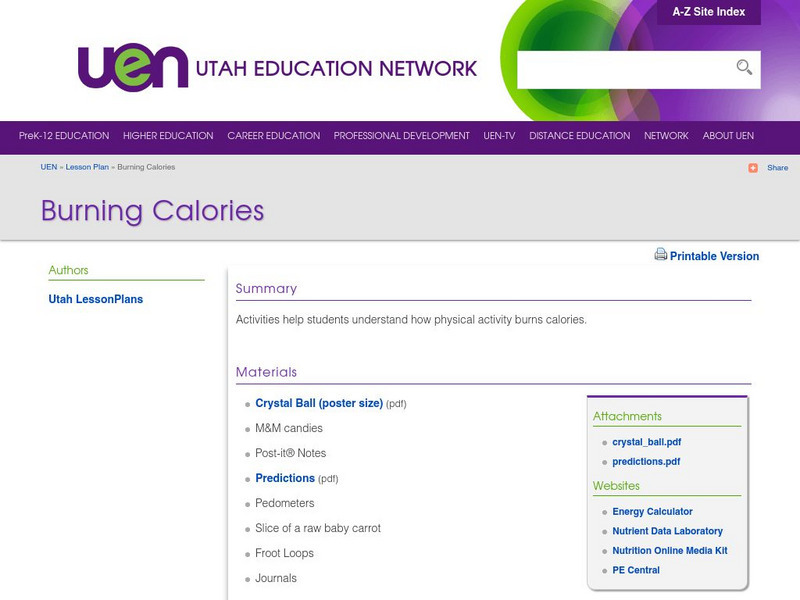Curated OER
Math in Science-Knowing the Calories You Take In!
I can burn off one scrambled egg in 30 minutes of walking? Explain how we daily consume and burn calories using this fun worksheet, which breaks down basic foods and activities into kilocalorie equivalents. Nutritionists calculate the...
Curated OER
How Much Do You Burn?
Sixth graders discover their weight relative to the other children in their class. They determine how many calories they burn through exercise and compare it with their classmates. Using the internet, they calculate their body mass index...
Curated OER
Get Physically Active
Students discover the importance of water. In this physical education science lesson, students consider mental and physical activities. Students find their pulse and measure their heart rate. Students discuss the importance...
Curated OER
Calorie Connection
Students calculate the calories in a Brazil nut and the calories needed for daily intake. For this calories lesson plan, students use calorimetry to measure the change in water temperature heated by the burning of a Brazil nut. They also...
Curated OER
Measuring Calories
Students burn peanuts and marshmallows to determine the calories each contains. In this calorimetry lesson, students set up an apparatus with a ring stand and water in an aluminum can. They record the temperature of the water before and...
Curated OER
Measuring Calories
Students investigate what a calorie is and how and why we measure them. They conduct an experiment to compare the calories of a peanut and a mini-marshmallow, and explain and discuss how calories are directly related to the amount of...
Curated OER
What The Peanuts Say: Catabolism and Calories
Students investigate the energy released by a peanut and a piece of a walnut. In this catabolism and calories lesson plan, students burn a peanut and a piece of a walnut and measure the temperature of the water before burning and after...
Curated OER
Measuring Calories in Food
Students measure the amount of calories in food. In this food energy lesson, students discuss what a calorie is, how our bodies use a calorie, and how many we need. Then, students use a calorimeter to calculate the amount of energy in a...
University of Rhode Island
How Does the Human Body Use Energy during Various Athletic Activities?
Students investigate how much energy is used during different athletic activities. They conduct Internet research to obtain information on the top three athletic sporting events from around the world, and calculate the calories burned...
Polar Trec
Calorimetry Lab
Young people between the ages of 11–13 need on average about 2,000 calories per day. Within the lab, groups learn about calorimetry and respiration. They explore how it pertains to humans and animals living the Arctic where cold...
Baylor College
Energy Sources
Take the concept of burning calories to a more literal level in the second of seven lessons about energy in the realm of food and fitness. Using simple materials, groups will burn breakfast cereal and a pecan to see which one gives off...
Curated OER
Walk a Mile for a Burger?
Students are introduced to the pedometer, and use this tool to associate physical activity (physical energy) with calories burned (chemical energy). They comprehend the making and burning of energy.
University of Georgia
The Power of Peanuts
Measure the amount of energy in a peanut by igniting a chemical reaction. Classes use a laboratory setup to burn a peanut and measure the amount of heat it releases through a temperature analysis. They calculate the number of Joules of...
Curated OER
Cellular Respiration
In this cellular respiration worksheet, learners compare the following processes: cellular respiration, glycolysis, lactic acid fermentation, and alcoholic fermentation. This worksheet has 9 short answer, 6 matching, 3 multiple choice,...
Curated OER
Training Table Race
Young scholars investigate the role of the carbohydrates food group in sports performance. The difference between simple and complex carbohydrates, and the performance of cardiovascular activities form the focus of the lesson.
Curated OER
What Should I Know about Respiration
How are kids supposed to know what to study for that cellular respiration test? With a study guide or reading guide like the one found here. With three pages of questions important to the understanding of respiration and the processes...
Curated OER
Eating your Energy's Worth
Students calculate the amount of electrical energy used in a week in food units. They create ways to reduce energy use. Students discuss the different forms and sources of energy. They discuss how people use electrical energy to power...
Utah Education Network
Uen: Burning Calories
Second graders will investigate calorie usage in this activity. Students will make predictions, wear a pedometer, walk and record steps, and understand how high calorie foods require more calorie-burning effort.
Other
Fitness Partner: Activity Calorie Calculator
Let this exercise calculator figure the number of calories you burn while doing over 222 different physical activities.
Texas Instruments
Texas Instruments: Holt Modern Chemistry: Energy Content of Foods
This probeware Lab Energy Content of Foods from the chapter Causes of Change uses a temperature probe to calculate the temperature change of the water to determine how much energy was released when food samples burn.


